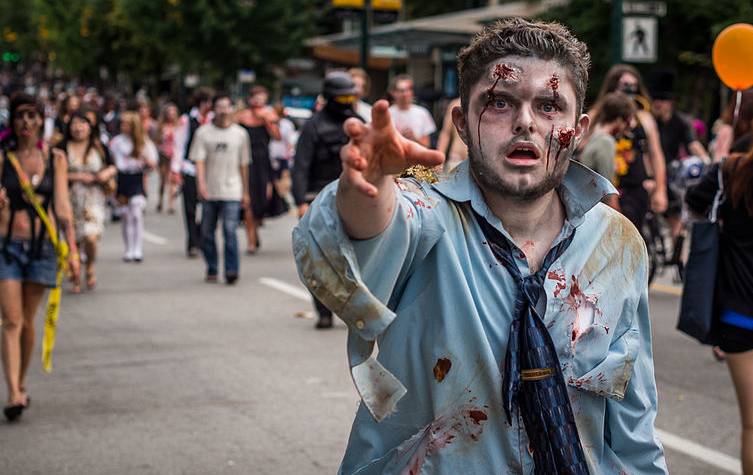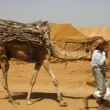Our fantasies of the predatory and non-conscious undead have something to do with the impasses in our social-political lives.
| Our social-political-economic world is founded on predation and unshakeable hierarchies. No other world is imaginable. How can it be changed? We find ourselves unable to say. But we can imagine how it could be destroyed. Asteroids, sunspots, economic and social crises, rising sea levels. Oh yes, and zombies. |
It’s never been accomplished, of course, though some attempts have come closer than others.
But it seems that today, with neoliberal, global capitalism ascendent and challenged only by the shadowy forces of global terror, these ideals of justice have become not just difficult to achieve—or not just impossible to achieve in full, which is a given—but impossible even to hold in our imagination. They have passed beyond the very boundaries of our thinking. Justice has actually, in our historical moment, become inconceivable.
And so the problem is worse than Eagleton thought. Those contradictions between individual and society have become the stuff not of tragedy, but of apocalypse.
Our social-political-economic world is founded now proudly and with assurance on predation and unshakeable hierarchies. No other world is imaginable. (No need to mention communism here. Communism is dead. For an attempt to resuscitate, see Eagleton’s Why Marx Was Right—praised by Publishers’ Weekly as “witty and entertaining”). How can this world be changed? How reformed? We find ourselves unable to say.
But we can imagine how it could be destroyed: asteroids, sunspots, economic and social crises, rising sea levels, pandemics, other climate-related catastrophes, terrorists with nuclear weapons, police states arising in response to these other calamities, attacks by aliens (from space, I mean—or, OK, from Mexico). Oh yes, and zombies.
As they say, it is easier to imagine the end of the world than the end of capitalism.
That’s where zombies come in.
They are the end of the world: apocalypse without revelation, without redemption, without sequel. They are the worst thing that could possibly happen. They resolve the contradiction between individual and society by abolishing both forever. They are the grave—but the grave without mourners, or posterity, or any hope of procreation. They are eternal and universal death—the reversal of all biology: a procreation and multitude based on death.
There is nothing in our current apocalyptic vocabulary more horrifying. To abandon ideals of justice and just alternatives to the present is to abandon the future. Is it any wonder that zombies have become the apocalyptic fantasy of choice?
Zombies, furthermore, answer the most pressing post-apocalyptic question. In all our favorite cinematic global catastrophes—in the complete Roland Emmerich oeuvre, for example (Independence Day, The Day After Tomorrow, 2012, and the new one, White House Down)—a significant portion of the world’s population is killed. But where are the dead?
Our protagonists survive, and the earth looks to a new dawn. But how does it look so pristine?
In a biological sense, it is no illusion or fantasy to depict the reanimated dead. The dead are not de-animated until all processes of decomposition have ceased. We imagine worlds of the dead, but repress this knowledge, and zombies are our return of the repressed. If all collapses, if most of us die, the dead will surely be active and animate. They will spread disease; the world will be theirs. The zombie fantasy gives this bio-apocalyptic truth and horror a narrative.
But there is also pleasure and satisfaction in this fantasy, as in most apocalyptic fantasies.
When all institutions go down and “mere anarchy is loosed upon the world,” as Yeats put it, then all violence becomes justified. When post-apocalyptic marauders of any description—zombies, aliens, punks, immigrants, cyborgs, urban hordes, misdirected consumers—threaten one’s home and family, the would-be survivor has both the obligation and the immense satisfaction of killing them. This is what our Doomsday Preppers dream of; at the end of the day, the occasion to use righteous violence is what they are preparing for.
And this is the ideology as well of most of our cinematic apocalypses—and quite pointedly, those with zombies. You can’t negotiate with them. It is pointless to study them. There is no cure. They have no demand other than your death. So blow their heads off!
And yet World War Z provides an interesting twist on the zombie apocalypse ideology.
The film opens according to standard zombie generic principles: a few happenstance attacks, viral acceleration, absolute horror and panic as the nature of the crisis reveals itself, a family in flight, the mirage of safe havens as the zombie horror engulfs everything, the collapse of society as such.
But then the rhythm changes.
Our family is rescued by a government helicopter and taken to a U.S. aircraft carrier where some semblance of institutional command still exists. Brad Pitt is a former United Nations trouble-shooter now called back into service. He will accompany the world’s top epidemiologist and a team of Navy Seals to search for a cure in Korea.
Korea does not pan out. The scientist is killed. But the trail then leads to Israel—protected from zombies by an enhanced version of its “separation barrier,” which now allows uninfected Palestinians their long-desired “right to return”! Nice touch there, though the wall doesn’t hold, and Jerusalem is overrun. From there, Pitt and a female Israeli soldier catch the last plane out and head to a still-functioning World Health Organization lab in Wales. There, after an extended final fight scene with a group of zombified biologists, Pitt and the surviving WHO staff discover, though not an actual cure or vaccine, a kind of biological camouflage that will allow soldiers to walk among zombies and kill them without being attacked—thus winning the zombie war.
As should be obvious, the zombie plot here has altered in important ways. This is not a George Romero movie or a season of “The Walking Dead.” In fact, we might conclude that World War Z is not a zombie movie at all. Institutional structures remain intact throughout the film, and the real plot is not about zombies, but about solving an epidemiological mystery. The zombies are defeated through the joint, heroic efforts of the UN and WHO, and the story resembles far more closely a film like Contagion than any of the Living Dead features.
Science, courage, imagination, sympathy, and democratic institutions together defeat the living dead. And the dead turn out to be finally a medical, not an existential, problem.
World War Z is, in fact, quite a rare generic offshoot—a liberal apocalypse. That is, an apocalypse that reveres the social institutions that more typical apocalyptic narratives delight in obliterating.
The zombies cannot be reasoned with or cured, but science has comprehended them; their otherness has been breached and contained.
This is quite different from the novel, by the way, in which the zombies are finally defeated at massive human cost and by means of a morally repugnant military strategy—but never are scientifically understood. They remain absolutely other—radically antithetical to all knowledge, emotion, language, and social order.
Just as a zombie should be.
James Berger is senior lecturer in American Studies and English at Yale University. He is the author of After the End: Representations of Post-Apocalypse. His forthcoming book is The Disarticulate: Language, Impairment, and the Narratives of Modernity.







0 Comments